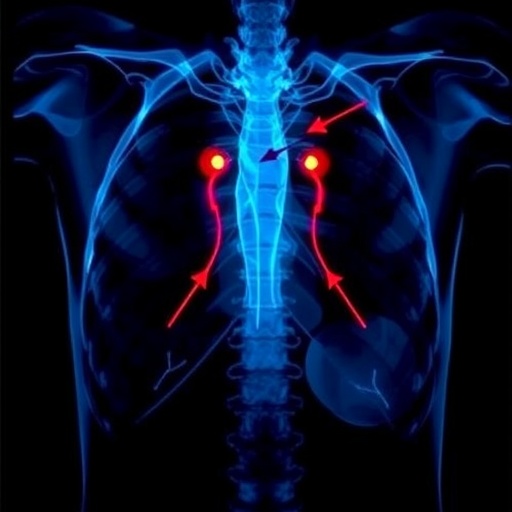Recent advancements in pediatric radiology have provided new insights into the management of aneurysmal bone cysts, particularly those located in close proximity to growth plates. A study titled “Aneurysmal bone cysts abutting the growth plate: evaluation of the impact of alcohol sclerotherapy,” authored by M. Pastor and colleagues, tackles this specific medical challenge. This research is groundbreaking as it focuses on an innovative treatment method—alcohol sclerotherapy, which could significantly alter current clinical practices in treating these complex lesions.
Aneurysmal bone cysts are benign but aggressive vascular lesions that often manifest in children and adolescents. Their occurrence near growth plates poses unique challenges for treatment because these areas are critical for bone growth and development. Traditional management strategies have included curettage followed by bone grafting, but these approaches are not always effective and may lead to complications such as fracture or impaired growth in the affected limb. Thus, there is an urgent need for novel therapeutic interventions, making the findings of Pastor et al. even more relevant.
Alcohol sclerotherapy is a minimally invasive technique that introduces alcohol into the cyst’s vascular structures, effectively reducing the lesion’s size and promoting healing. This method has gained traction in various medical fields, but its efficacy in treating aneurysmal bone cysts, especially near growth plates, has not been thoroughly evaluated until now. The meticulous study conducted by Pastor and his team aims to fill this knowledge gap by rigorously assessing the outcomes of this treatment modality.
This study engaged several pediatric patients diagnosed with aneurysmal bone cysts close to their growth plates, providing a diverse dataset for analysis. The authors employed various imaging modalities, such as ultrasound and MRI, to ensure accurate diagnosis and to monitor the effectiveness of the sclerotherapy. Patients were carefully monitored post-procedure, with follow-up imaging performed at regular intervals to evaluate the response and any potential complications arising from the treatment.
One of the pivotal findings of this research is the notable reduction in cyst size following alcohol sclerotherapy. The authors report that the majority of patients experienced significant improvements, with many cysts either stabilizing or completely resolving after treatment. This outcome suggests that alcohol sclerotherapy could serve as a viable alternative to traditional surgical approaches, reducing the need for more invasive interventions that could risk growth plate integrity.
In addition to measuring cyst size, the researchers also assessed functional outcomes and the psychosocial impact of the procedure on young patients. Importantly, the study documented negligible adverse effects associated with sclerotherapy, emphasizing its safety in a vulnerable pediatric population. This aspect is particularly critical, given that many treatment strategies for bone cysts could negatively influence a child’s physical and emotional well-being.
Beyond addressing effectiveness and safety, Pastor et al. also explored the broader implications of adopting alcohol sclerotherapy as a standard treatment. The potential to minimize hospital stays, reduce recovery times, and enable patients to return to normal activities more swiftly underscores the practical advantages of this approach. Such benefits could profoundly affect healthcare resource allocation and enhance patient satisfaction in pediatric care.
However, while the findings are promising, the authors caution against generalizing results without further research. The study acknowledges the requirement for larger-scale trials to substantiate the safety and efficacy of alcohol sclerotherapy across varied demographics. This would include evaluating long-term outcomes, such as the potential for recurrence of cysts after treatment or any latent effects on bone growth over time.
The ongoing dialogue within the medical community surrounding the treatment of aneurysmal bone cysts highlights the need for continuous evaluation of methods. As more studies emerge, they can assist in establishing evidence-based guidelines for managing these challenging cases. Substantial progress has already been made, yet the path forward must be paved with rigorous inquiry backed by robust data.
Overall, the research led by Pastor and colleagues presents a significant shift in the paradigm of managing aneurysmal bone cysts in pediatric patients. Their emphasis on alcohol sclerotherapy may not only facilitate better outcomes for patients but may also inspire further innovation in minimally invasive techniques across various medical disciplines.
Such a transformative study invites healthcare professionals and researchers alike to contemplate how similar approaches can be adapted and applied to other benign lesions, potentially reshaping pediatric orthopedic practices overall. The researchers’ diligent work serves as a compelling reminder of the importance of continually pushing the boundaries of medical knowledge while ensuring the safety and well-being of young patients is at the forefront of all endeavors.
The quest for improved therapeutic techniques in managing conditions like aneurysmal bone cysts is far from over. As we await further developments in the investigation into alcohol sclerotherapy and its role in pediatric radiology




